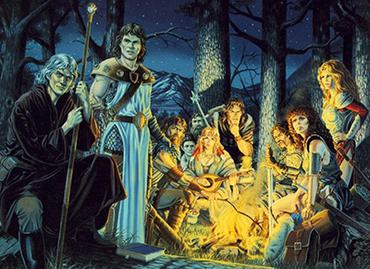A few months ago, I discussed the importance of the group putting a "social contract" in place, preferably before play begins. However, before you can have a "social contract" for your game, you need players. So, this week, I wanted to focus on an issue that affects every game and every table: Finding Players.
This discussion is inspired by a recent conversation and assumes the point of view of a game master.
Being the game master is great fun for a number of reasons, not the least of which is that you get to pick the game you want to play. However, it's an obvious condition precedent to gaming that you first need to get other people who buy in to your idea for a game or campaign. Indeed, more than a few campaigns have stalled, collapsed, or not even gotten off the ground due to a lack of players. Moreover, even if you already have a group, this is something you should still think about recruiting more players because most, if not all, groups suffer constant attrition from the vagaries of life (e.g., new job, new school, changed life circumstances, etc.).
Finding players is a question of marketing, so before you even start looking for players, it behooves you put together a winning pitch to sell your campaign.
When putting together a pitch, you should be able to describe what kind of game you want to run in a short, clear, and engaging manner. Prospective players should be able to quickly understand what you want to do in a way that (hopefully) fires up the imagination. For example, I'm currently recruiting for a second concurrent Sorcery & Steel campaign and I pitch it as "Wander the eastern Mediterranean in a tramp freighter during classical Antiquity" or "Traveller/Firefly meets old D&D."
If you are able to interest someone with the pitch, you should have additional details (e.g., Play Location/Method, Game/System, Time/Frequency, etc.) ready. Don't be discouraged if you don't hook people right away, though if you are having difficulty, perhaps you need to hone your pitch.
Once you have your pitch down, where do you pitch? Roleplaying is a collaborative form of storytelling, so you need to find collaborators. To that end, work your social networks, both offline (e.g., friends, family, co-workers, etc.) and online (e.g., Facebook, Twitter, Instagram, etc.). Don't forget corkboards at your local friendly gaming store (if your town has one), library, etc.
There are also recruiting forums at most online RPG communities and other websites (e.g., Craigslist). However, the best results I've gotten are from Meetup.com.
Assuming you have the luxury of enough players for your campaign, I like to vet players as much as possible before allowing them to join and sites like Meetup are good because if someone volunteers information about themselves, that's a good sign. If that information matches your playstyles and other preferences, even better!
Good players are worth their weight in gold, while disruptive players can quickly make things unfun for everyone else, so the time you invest here is more than worth it. Best of luck!














.JPG/729px-Frank_Mentzer_-_Lucca_Comics_%26_Games_2014_(cropped).JPG)




